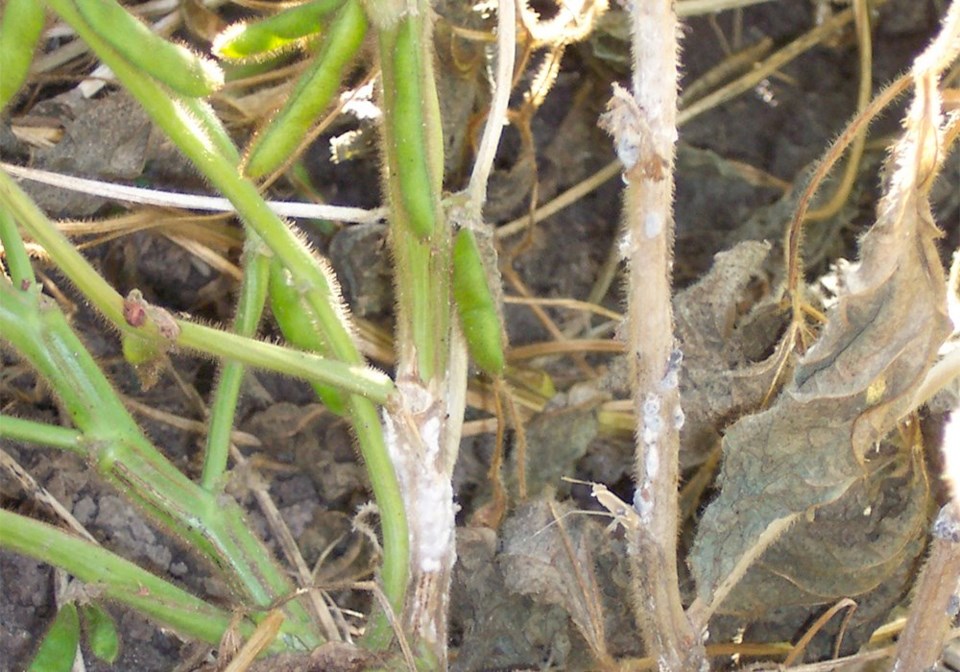WESTERN PRODUCER — White mould stem rot is a destructive crop disease that is widespread in Canada.
It infects more than 600 plant species including crops such as potatoes, soybeans, sunflowers, peas, lentils, canola as well as other broadleaf crops. It can cause 50 percent yield loss in some cases.
The disease is caused by a protein in the fungus Sclerotinia sclerotiorum. Recently, scientists with the United States Department of Agriculture’s Agricultural Research Service and Washington State University identified the protein as SsPINE1. Knowledge of the protein offers opportunities for researchers to develop more precise measures to combat the disease.
The fungus secretes chemicals that break down the plant’s cell walls. The chemicals are called polygalacturonases, or PG. Plants, in turn, protect themselves by producing a protein labelled PGIP that stops PG. PGIP was discovered in 1971 but since then, while scientists have suspected the pathogen has an ability to get around PGIP, they have not been able to identify it. That countermeasure came to light with the discovery of the newly identified protein SsPINE1.
Essentially, all these countermeasures have become attack-counterattack warfare between the pathogen and its plant host as each tries to bypass or overcome the other’s defences.
“Although we were not specifically looking for SsPINE1, we were studying pathogenicity mechanisms of Sclerotinia sclerotiorum and how it causes disease,” said Weidong Chen, research plant pathologist, ARS adjunct professor at the department of plant pathology at WSU.
The research team first determined the fungus’ genes that were activated during early stages of the plant’s infection. Identifying the genes led to the discovery of the secreted protein SsPINE1. They then deleted individual genes in the fungus and, when SsPINE1 was deleted, the pathogen had significantly less ability to cause damage to the plant. What they then needed to know was exactly how SsPINE1 impacted the plant.
“Since SsPINE1 is important for causing disease and is a secreted protein from the pathogen, we reasoned that it must act on the plant,” said Chen. “We used SsPINE1 to screen plant genes to determine which ones were interacting with SsPINE1. When we saw that SsPINE1 interacted with the plant’s inhibiting protein PGIP, it meant that SsPINE1 targets PGIP protein.”
That really made sense to the research team because PGIP was supposed to interact with and inhibit the pathogen’s PG. But the interaction between SsPINE1 and PGIP actually disabled PGIP’s function.
The key to identifying SsPINE1 was looking outside the fungi cells at the material that had been excreted. To prove that the discovered protein allowed PG to bypass the plant’s PGIP, they deleted the protein from the fungus in the lab. This dramatically reduced its impact.
“I got goosebumps when we found this protein,” Kiwamu Tanaka, associate professor in WSU’s department of plant pathology, said in a news release. “It answered all these questions scientists have had for the last 50 years. Why do these fungi always overcome plant defences? Why do they have such a broad host range and why are they so successful?”
Chen said that the connection between SsPINE1 and PGIP is through interactions of individual amino acid residues of the two proteins. It is possible to reduce or abolish the interaction by changing the amino acid residues without altering the whole protein structure.
“We can change the interacting amino acid residues in PGIP in such a way that it does not interact with SsPINE1,” he said. “In other words, SsPINE1 cannot recognize the altered PGIP anymore. It loses its function. Plant breeders can put the altered PGIP into crop plants through genetic modification.”
Having narrowed down the region in which PGIP interacts with SsPINE1, the researchers used a highly effective PGIP from chickpea to identify which amino acid residues are involved in the SsPINE1 interaction. This information will allow them to modify the amino acids residues to make PGIP unrecognizable to SsPINE1. The protein is essentially neutralized and the crop’s resistance to the pathogen is increased. The altered PGIP will be placed into plants to see how they function.
Chen added they are mindful that PGIP also inhibits the pathogen PG through interactions of individual amino acid residues, and they need to make sure that the altered PGIP retains its function inhibiting the chemical.
“After confirming its functions, we can use the altered and improved PGIP in plant breeding,” he said. “In traditional resistance breeding, plant breeders will select a resistant parent to cross with a desirable but susceptible parent to transfer the resistance trait to the susceptible parent, by selecting for resistance in a large population of the cross offspring. This approach is kind of random without a specific target.
“For white mould disease caused by S. sclerotiorum, no resistance sources are available in many economically important crops. For example, we have been screening germplasm accessions of pea for years. We have not found any resistance source that can be used in pea breeding. The discovery of SsPINE1 offers a target for improving plant resistance. Altering plant PGIP increases the precision in improving crop resistance.”
The discovery of SsPINE1 has opened several avenues to explore for controlling white mould stem rot pathogens including targeted breeding methods to create plant varieties that would be naturally resistant to sclerotinia fungus diseases.
The research was published in the journal Nature Communications.





